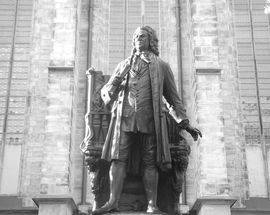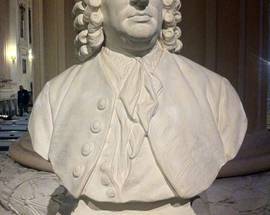Johann Sebastian Bach
more than a year agoTypical of human history, Bach didn’t attain his celebrity status in Leipzig until long after his death in 1750. He began life in the metropolitan trade city as cantor of St. Thomas Church and director of church music. The position was originally supposed to go to Georg Philipp Telemann, who, unlike Bach, was a famous composer. But, using the job offer to squeeze some more money out of his bosses in Hamburg, Telemann politely declined. The search continued for half a year until Christoph Graupner recommended the future genius. Unable to get the best, the council settled for Johann, and in 1723, he started his new job.
The early years weren’t easy for the new choir master. His responsibilities as cantor of St. Thomas Church included teaching music and Latin, arranging performances for three other churches and composing cantatas and other music for the services. In order to pay for their schooling, the boys were expected to sing in the choir. They and their new director had to perform at weddings, funerals and celebrations, including holidays. Bach was performing for an average of one funeral a day. In times of mild weather, however, this number significantly dropped, and Bach was frustrated by the lack of such ceremonies and the money they brought.
Bach’s salary of 100 talers was less than he was led to believe by the council. In addition, his workload was preventing him from developing other projects. His vocal displeasure of both his pay and working conditions did not win him many sympathizers among the council members, who still saw him as merely the third choice behind Telemann and Graupner. They began to allow boys with no musical talent into the school, further complicating Bach’s responsibilities regarding the choir. At the same time, much needed funds to finance a respectable orchestra were missing, and the rift between the cantor and the council grew. This led to Bach taking unexcused leaves from his position to pursue other interests. He sometimes took his sons to Dresden for opera performances or spent time trying out new organs.
Despite the heavy workload and the internal conflicts with his employers, Bach turned out compositions at an exceptionally prolific rate. In a direct affront to procrastinators everywhere, he had composed enough cantatas for church services within his first three years in Leipzig to allow him time for other interests. It is believed that he produced 52 ‘chorale cantatas’ in 1724 alone.
Things started to look up in 1730, when Johann Matthias Gesner, an acquaintance of Bach’s from Weimar, took over as rector. He recognized Bach as an exceptional talent and approved of his methods. Within a short amount of time the school (and Bach’s flat) were renovated, and the music school was finally given the same status as the school of sciences. But, like a fairy tale from the Brothers Grimm, the good rector Gesner was soon replaced by the evil rector Johann August Ernesti. The new rector had modern ideas of education and was a professed opponent to music, and so Bach’s earlier problems with money and choir singers soon returned.
Over the next four years, however, Bach’s power and influence grew. In 1736 he became court composer to the elector of Saxony. By 1738 he held sufficient sway to get essentially whatever he wanted. He continued composing, producing the majority of his life’s work in Leipzig and also took on many other official and honorary positions.
He died in 1750 most likely of a stroke, though his health in general had been deteriorating for some time. Even at the end of his life, Bach was still not recognized in his adopted home city as a musical genius. When he was buried at the Church of St. John the Baptist, he was not even dignified with a headstone at his grave site. His remains were not moved to St. Thomas Church until 1950.




---manuscript---05_m.jpg)
Comments